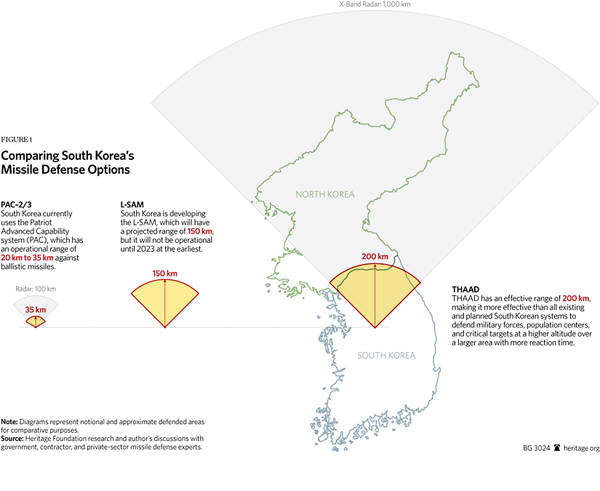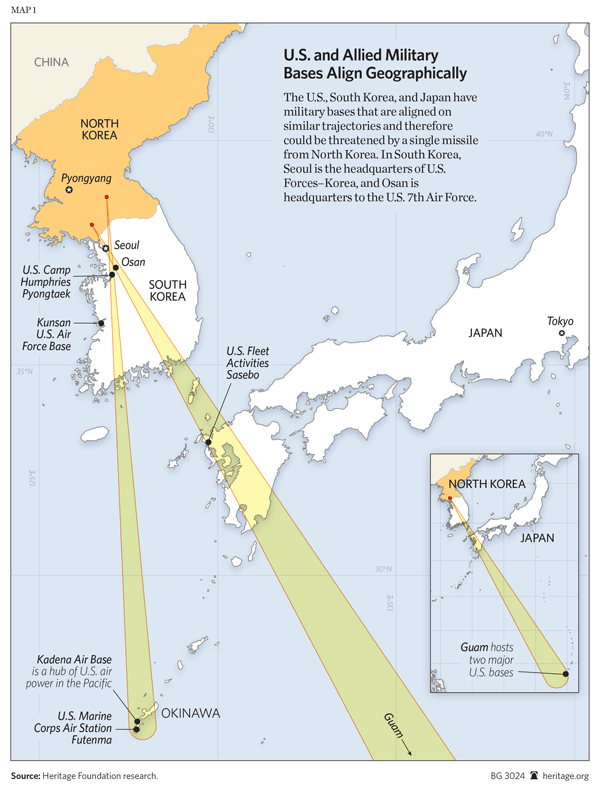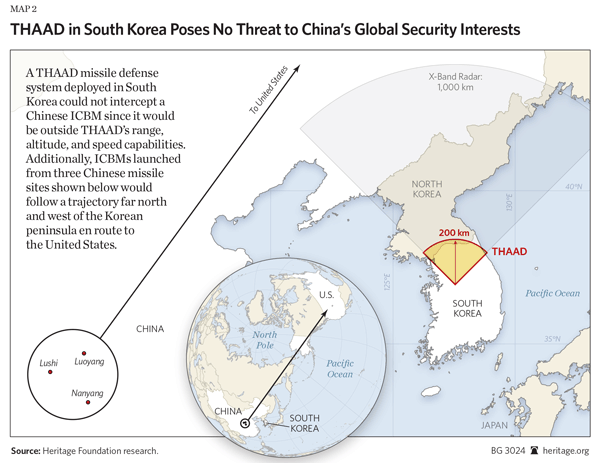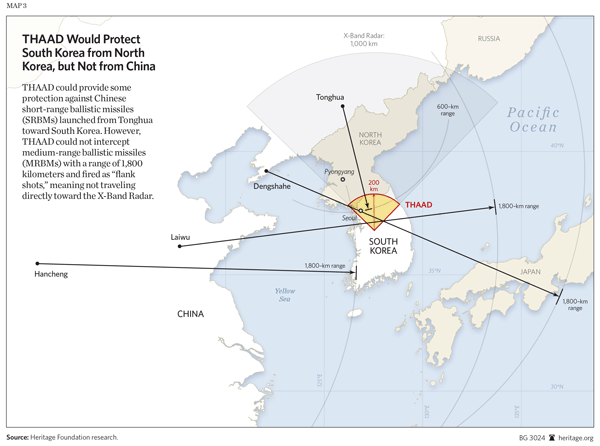The April 2015 interim nuclear agreement with Iran has generated speculation that a similar denuclearization agreement might be possible with North Korea. However, Pyongyang has made emphatically clear that it will never abandon its nuclear arsenal and has declared the Six-Party Talks “null and void.”[1]
The U.S. and its allies therefore need to deploy sufficient defenses to deter and defend against the growing North Korean missile and nuclear threats. Washington, Seoul, and Tokyo need a comprehensive, interoperable, and multilayered ballistic missile defense (BMD) system. Multiple systems providing complementary capabilities improve the likelihood of successful defense against missile attack.
Yet South Korea persists in resisting both deployment of more effective interceptors and incorporating its independent system into a comprehensive allied network. Even the potential U.S. deployment of Terminal High Altitude Area Defense (THAAD) to strengthen alliance BMD on the Korean Peninsula has been controversial due to Chinese pressure on Seoul.
The Park Geun-hye administration is pursuing a policy of “strategic ambiguity” in order to postpone public discussion on THAAD deployment. South Korea should instead articulate to its citizens—and the Chinese and Russian leaderships—the need for a more effective missile defense system to protect the country better. Seoul should rebuff Chinese interference and exercise its sovereign right to defend itself against the North Korean threat brought on, in part, by Beijing’s unwillingness to confront its belligerent ally.
Growing North Korean Nuclear and Missile Threats
Pyongyang asserts that it already has the ability to attack the continental United States, American bases in the Pacific, and U.S. allies South Korea and Japan with nuclear weapons. In March 2015, North Korean Foreign Minister Ri Su-yong warned that Pyongyang now “has the power of conducting a pre-emptive strike.”[2] Pyongyang announced that its February 2013 nuclear test was of a “miniaturized and lighter” nuclear weapon that could fit on a missile, giving the regime the ability to “make a precision strike at bases of aggression and blow them up with a single blow, no matter where they are on earth.”[3]
North Korea has an extensive ballistic missile force that could strike South Korea, Japan, and U.S. military bases in Asia. Pyongyang has deployed at least 400 Scud short-range tactical ballistic missiles, 300 No-Dong medium-range missiles, and 100 to 200 Musudan intermediate-range ballistic missiles. The Scud missiles threaten South Korea, the No-Dong can range a portion of South Korea and all of Japan, and the Musudan can hit U.S. bases on Okinawa and Guam.
U.S. experts estimate that Pyongyang currently has 10–16 nuclear weapons.[4] Dr. Siegfried Hecker, former director of the Los Alamos National Laboratory, has concluded that North Korea could have 20 nuclear weapons by 2016.[5] Chinese nuclear experts have warned that North Korea may already have 20 nuclear warheads and could enrich enough uranium to double its arsenal by 2016.[6] The Korea Institute at the Johns Hopkins School of Advanced International Studies (SAIS) has predicted a worst-case scenario of Pyongyang having 100 nuclear weapons by 2020.[7]
Enough unclassified evidence is available to conclude that the regime has likely achieved warhead miniaturization—the ability to place nuclear weapons on its No Dong medium-range ballistic missiles—and can threaten Japan and South Korea with nuclear weapons.[8]
Following an August 2013 meeting between South Korean Minister of Defense Kim Kwan-jin and U.S. Secretary of Defense Chuck Hagel, a Ministry of Defense official commented that both countries agreed that North Korea could “miniaturize nuclear warheads small enough to mount on ballistic missiles in the near future.”[9] In April 2013, U.S. officials told reporters that North Korea “can put a nuclear weapon on a missile, that they have missile-deliverable nuclear weapons, but not ones that can go more than 1,000 miles.”[10]
In October 2014, General Curtis M. Scaparrotti, senior U.S. commander on the Korean Peninsula, told reporters that North Korea has the ability to produce a miniaturized nuclear warhead that can be mounted on a ballistic missile.[11] A South Korean National Assembly member revealed that some of the flight tests of No Dong missiles were flown on a higher trajectory in order to reduce their range to 650 kilometers. As such, a No Dong missile could be used to attack South Korea with a nuclear, chemical, or biological weapon.[12]
North Korea Threatens Nuclear Attacks
North Korea has repeatedly threatened to use its nuclear arsenal in preemptive attacks against the United States, South Korea, and Japan. According to a senior North Korean military defector, in 2012, Kim Jong-un approved a new war plan in which Pyongyang would use nuclear weapons early in a conflict—prior to U.S. reinforcements arriving—in order to occupy all of South Korea within seven days.[13]
In 2013, the regime declared that inter-Korean relations were in a state of war after it revoked the armistice ending the Korean War, all inter-Korean non-aggression agreements, and all previous North Korean commitments to abandon its nuclear weapons. The North Korean People’s Army warned that “the [South Korean] presidential Blue House and all headquarters of the puppet regime will be targeted. If the South recklessly provokes us again, the sea of fire at Yeonpyeong will turn into a sea of fire at the Blue House.”[14]
In March 2013, the North Korean Workers’ Party Central Committee decided:
[A]ny military provocation in the West Sea of Korea or along the Military Demarcation Line will not be limited to a local war, but develop into an all-out war, a nuclear war. [The first strike will reduce] U.S. military bases in South Korea and [South Korean] ruling institutions including [the Blue House] and puppet army’s bases to ashes at once.[15]
North Korea also threatened to turn Seoul and Washington into “seas of fire” through a “precise nuclear strike.”[16]
Inadequate South Korean Missile Defense
The South Korean constitution charges its armed forces with “the sacred mission of national security and the defense of the land.”[17] Protecting against the catastrophic devastation from a North Korean nuclear attack is a critical responsibility. Despite the growing North Korean threat, successive liberal and conservative South Korean governments resisted deploying adequate missile defense systems and linking its network into a more comprehensive and effective allied BMD framework.
Only Low-Level Interceptors. South Korea is instead developing the independent Korea Air and Missile Defense (KAMD) system, which would consist of only a terminal phase, lower tier land-based Patriot-2 missiles and SM-2 Block IIIA/B missiles deployed on Aegis destroyers without ballistic missile capability. Seoul purchased two Israeli-produced Green Pine radars and announced plans to procure 68 PAC-3 missiles.[18] South Korea is indigenously developing the Cheolmae 4-H long-range surface-to-air missile (L-SAM).
Resisting an Allied System. Successive South Korean administrations, including President Park Geun-hye, have resisted joining a comprehensive allied program. In June 2012, Seoul canceled at the last moment the scheduled signing with Japan of a bilateral General Security of Military Information Agreement (GSOMIA), which would have enabled exchanging intelligence on North Korea’s nuclear and missile programs.
The agreement would have provided Seoul with access to information collected by Japan’s high-tech intelligence satellites, Aegis ships, and early-warning and anti-submarine aircraft, thus improving South Korean defense against North Korean missiles. But lingering South Korean animosities stemming from Japan’s occupation of the Korean Peninsula in the 20th century forced Seoul to cancel the agreement. In December 2014, a modified version of the agreement was signed which allows voluntary passing of intelligence about North Korean ballistic missile and nuclear activities between Japan and South Korea through the U.S. Department of Defense.
Need for Layered Missile Defense
A basic precept of air and missile defense is “mass and mix”—having sufficient interceptors from different systems so that any one system’s vulnerabilities are offset by the capabilities of another system. Instead, South Korea insists on relying on only lower-altitude interceptors, resulting in smaller protected zones, gaps of coverage that leave fewer citizens protected, and minimal time to intercept a missile—all of which contribute to a greater potential for catastrophic failure.
Successfully destroying a high-speed inbound missile requires intercepting it sufficiently far away from the target. The higher the altitude and range of the interceptor, the greater the likelihood of success. At low altitude, even a “successful” interception of a nuclear, chemical, or biological warhead could result in the populace still being harmed. Seoul’s insistence on only a last ditch interceptor is like a soccer coach dismissing all of the team’s players except the goalie, preferring to rely on only one player to defend against defeat.
The THAAD system is designed to intercept short-range, medium-range, and some intermediate-range ballistic missiles’ trajectories at endo-atmospheric and exo-atmospheric altitudes in their terminal phase. In conjunction with the Patriot missile system, THAAD would create an essential multilayered defensive shield for South Korea. THAAD’s large-area defense capability with 72 interceptors per battery would complement Patriot’s point defense and enable defense of more military forces, population centers, and critical targets.
South Korea’s Hannam University conducted a computer simulation that showed a PAC-2/3 low-altitude missile defense system would have only one second to intercept a North Korean missile at a range of 12–15 kilometers (km), while a THAAD medium-range system would have 45 seconds to intercept a missile at 40–150 km.[19]
South Korea’s planned indigenous L-SAM would have less altitude and range than THAAD and would not be available for deployment until at least 2023. However, that target date is unlikely since creating a missile defense system is a long, expensive, and difficult process. For example, THAAD took approximately 30 years for the U.S. to fully develop, test, and field. The THAAD system has already been developed, tested (scoring a 100 percent success rate of 11 for 11 successful intercepts), and deployed.
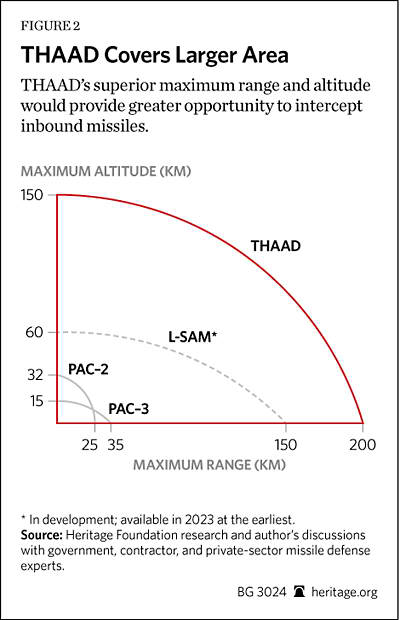
A Lockheed Martin simulation showed that a single THAAD battery could defend most of South Korea against a North Korean missile attack, while two batteries would protect all of Korea except the southeast and provide greater protection against multiple missile attacks. Three batteries would cover all of South Korea.[20]
The four most recent senior U.S. commanders in Korea[21] have recommended that South Korea should deploy the THAAD system and join the allied missile defense network. Similarly, the two most recent South Korean Defense Ministers Han Min Koo and Kim Kwan-jin have assessed that THAAD would improve the country’s defense.
Need for Allied BMD Interoperability
Missile defense is most effective when systems are incorporated into a seamless and cohesive network. Linking South Korean, U.S., and Japanese sensors would enable more accurate interceptions by tracking attacking missiles from multiple angles and multiple points throughout the flight trajectory, similar to three outfielders communicating with each other to coordinate catching a fly ball. In the instance of multiple inbound targets, interoperability would allow directing an individual outfielder (or BMD system) to specific targets to enhance success.
South Korea, Japan, and U.S. forces in both countries face a common threat from North Korean missiles. Map 1 shows how military bases of all three countries are aligned along a common azimuth and can be threatened by a single North Korean missile. A common threat should be addressed with an interoperable, multilateral defense.
As General B. B. Bell (ret.) explained at a 2014 Heritage Foundation event:
If each allied country is making its own assessments and developing its own attack response decisions—decisions which are required in seconds and even milleseconds—effective theater missile defense will have large gaps, decision inadequacies, training shortfalls, and stunningly dangerous procurement shortfalls.[22]
Bell therefore advocates
an integrated joint and combined missile defense control capability to detect, track, sort, prioritize and allocate tactical, regional, and medium range missile defense systems against multiple simultaneous atmospheric supersonic North Korean inbound missiles. Allied land and sea-based radars must be fully interoperable and provide a single headquarters with a clear picture, tracking data, and likely terminal targets for enemy airborne missiles, then the headquarters must allocate appropriate land and sea-based interceptor capability to defeat the attacks. Much of this must be done so quickly that only a unified response center can make the appropriate decisions.[23]
South Korea Avoids Deployment and Discussion
Given the increasingly dangerous North Korean threat, it is puzzling that South Korea continues to insist on a less effective defense of its citizens, resisting even the U.S. deploying its own THAAD to the Korean Peninsula. The Park Geun-hye administration has avoided public debate on THAAD by claiming that there has not been any form of “official” discussion between Seoul and Washington on a critical security issue that is already the subject of heated domestic public and media debate, National Assembly inquiries, and Chinese arm-twisting at the presidential level. South Korean presidential spokesman Min Kyung-wook described Seoul’s position as three no’s: “no [U.S. deployment] request, no consultation, and no decision.”[24]
Seoul’s resistance and reluctance even to discuss an issue deemed “controversial” is due primarily to concerns of aggravating China. South Korean media depicts the decision on THAAD as placing Seoul between competing pressures from two superpowers, citing the Korean adage “when whales fight, the shrimp’s back is broken.” The prevalent media advice is for Seoul to neither procure for itself nor allow U.S. deployment of THAAD so as not to offend China, which is South Korea’s largest trading partner.
China has made it clear that it wants South Korea to eschew THAAD:
- In March 2015, China’s Assistant Foreign Minister Liu Jianchao publicly expressed that South Korea and the U.S. should make an “appropriate” decision on THAAD “taking account of China’s concerns and worries.”[25]
- In February 2015, Chinese Minister of Defense Chang Wanquan expressed “concerns” about the possible U.S. deployment of THAAD in South Korea during his talks with Republic of Korea Defense Minister Han Min-koo.[26]
- In July 2014, Chinese President Xi Jinping told President Park Geun-hye to “tread carefully”[27] since the deployment of THAAD missiles on the Korean Peninsula went against China’s security interests. Xi asked Park to turn down any U.S. request so it “won’t be a problem between South Korea and China.”[28]
- In July 2014, Chinese Foreign Minister Liu Zhenmin told South Korean reporters, “China doesn’t want tensions rising or an arms race happening in Northeast Asia. Introducing a missile defense system on the Korean Peninsula is not good for the strategic balance.”[29]
- In May 2014, China’s state-run Xinhua News Agency threatened, “South Korea will sacrifice its fast-developing relations with China if it should be seduced into the [missile] defense network, ignoring the protests of the largest economy in Asia.”[30]
Recently, South Korean public opinion has shifted against Beijing’s heavy-handed tactics on THAAD amid concerns of becoming too subservient to Chinese pressure. A February 2015 JoongAng Ilbo poll showed that 56 percent of respondents favored THAAD deployment.[31]
China’s Red Herrings on THAAD
Beijing claims that THAAD deployment would be against China’s security interests, overlooking, of course, that North Korean development of nuclear weapons and missiles—and the repeated threats to use them—go against South Korean and U.S. security interests.
Beijing has not articulated the object of its complaint. Is it really the THAAD interceptor missiles, X-band radar, and the technical linking of South Korea’s KAMD into an allied system, or is it increased security cooperation among the U.S. and its allies? It is instructive to look at the facts.
THAAD Cannot Intercept Chinese Ballistic Missiles. While deploying THAAD would improve South Korean defenses against a North Korean attack, it could not intercept Chinese intercontinental ballistic missiles (ICBMs) launched against the United States.
- Chinese ICBM trajectories would exceed THAAD interceptor range, altitude, and speed capabilities. Only ground-based interceptors based in Alaska and California are designed to intercept an ICBM launched from Asia toward the United States.[32]
- THAAD interceptors based in Korea would offer the wrong interception profile. They are designed to attack missiles heading toward the interceptors in the terminal inbound phase, not an outbound ICBM flying away in its boost and mid-range phases.
- THAAD’s X-Band radar could not see or track the ICBMs. The radar, which can only see in a 90-degree arc, would be directed at North Korea, not China. Chinese ICBM trajectories would be outside the X-band radar range.
Even U.S. Homeland BMD Does Not Deter Chinese ICBMs. Washington has emphasized that even its homeland BMD capabilities based in the continental United States defend against only a limited ICBM attack from North Korea and Iran and are not intended or scaled to affect China’s or Russia’s nuclear forces. According to the Obama Administration, a comprehensive U.S. defense against the larger and more sophisticated Chinese and Russian arsenals would be “extremely challenging and costly.”[33]
THAAD Poorly Positioned Against Chinese Medium-Range Missiles
Examining the locations of Chinese short-range ballistic missile (SRBM) and medium-range ballistic missile (MRBM) units indicates that THAAD could theoretically help to defend against a Chinese DF-15 SRBM attack on South Korea from Tonghua in northeast China since those missiles would fly along the same trajectory as a missile launched from North Korea. However, the THAAD radar would not be optimized to do more than its assigned task of looking at designated North Korean areas for missile launches.
However, THAAD missiles could not intercept Chinese DF-21 MRBMs launched from Dengshahe, Laiwu, or Hanchang eastward toward South Korea or Japan. Interceptors have to be deployed in front of the radar, making intercepting a “flank-shot” missile that is not traveling directly toward the radar and interceptors extremely difficult if not impossible. The THAAD X-Band radar would have minimal, if any, capabilities to monitor Chinese missiles attacking South Korea or Japan. U.S. defense officials assert that the THAAD system in South Korea would be configured in “terminal mode” to optimize observation and interception of North Korea ballistic missiles before they reach targets in South Korea. This mode has a shorter radar range and would therefore not have much coverage over Chinese territory. Shifting the radar toward China would eliminate coverage of North Korea—the primary objective of deploying the THAAD to South Korea.[34]
China Resisting What It Has and Sells. Beijing warns of the destabilizing nature of BMD. A joint Chinese–Russian statement in March 2013 called on the international community “to act cautiously” in deploying and cooperating on BMD and voiced opposition to “the unilateral and unchecked buildup of anti-missile capabilities by a country or a group of countries to the detriment of strategic stability and international security.”[35]
In 2012, the Director-General for Asian Affairs in the Chinese Ministry of Foreign Affairs stated that “building a missile defense system in the Asia-Pacific region will have negative effects on global and regional strategic stability, and go against the security needs of the countries in the Asia-Pacific region.”[36]
Yet China is developing its own missile defense system. Beijing publicly announced that it conducted ground-based mid-course BMD tests in 2010, 2013, and 2014.[37] Moreover, Beijing is attempting to sell its FD-2000/HQ-9 BMD to Turkey. The FD-2000 interceptor has a range of 125 km and altitude of 27 km.[38]
China Should Not Be Concerned with a Defensive System. Beijing should be less concerned with THAAD than with Seoul’s “Kill Chain” strategy. While THAAD is a defensive system, the latter is a pre-emptive attack strategy. By not deploying THAAD, Seoul would be more reliant on a tripwire, escalatory policy that requires perfect intelligence to identify and track a North Korean mobile missile in the field, discern the type of warhead, and assess the North Korean leadership’s intentions (training, political gesture, or imminent attack) with sufficient time to attack before the missile launch.
The Kill Chain strategy assumes that the South Korean president would authorize a preemptive attack on North Korea and thus be potentially responsible for triggering an all-out war on the Korean Peninsula with a nuclear-armed enemy.
Implications of Chinese Pressure
Deploying THAAD to South Korea would clearly not threaten China in any way. One is left to conclude that, if not extraordinarily ill-informed, Chinese technical objections can only be disingenuous, and Beijing’s true objective is preventing improvement in allied defensive capabilities and multilateral cooperation.
The THAAD deployment issue is a microcosm of the greater North Korea problem. Once again, China has shown itself to be more critical of South Korean reactions than to the precipitating North Korean threats, attacks, and violations. On the THAAD issue, China has taken Pyongyang’s side over that of Seoul, disregarding South Korea’s legitimate security concerns and fundamental sovereign right to defend itself against an unambiguous danger.
Beijing again characteristically pressures Seoul rather than Pyongyang. This is consistent with previous Chinese behavior when it impeded a more effective international response to North Korea’s sinking of the South Korean corvette Cheonan, artillery shelling of Yeonpyeong Island, and repeated violations of U.N. Security Council resolutions.
In essence, China wants to exercise a veto over Seoul’s defense procurement and national security decisions. China may be Seoul’s largest trading partner, but it clearly does not have South Korea’s best interests at heart in national security.
Defending South Korean Sovereignty
Seoul should abandon its policy of strategic ambiguity and instead emphasize that deployment of THAAD is a response to the growing North Korean nuclear threat and has no impact on Chinese security.
What the U.S. Should Do. The U.S. should:
- Fund its defense commitment to Asia. While the Obama Administration has been stalwart in its rhetoric pledging an Asia “pivot,” it has not provided the military budget necessary to fully honor American commitments to security in the Pacific.
- Engage in public diplomacy efforts in South Korea to articulate the North Korean missile threat and the necessity of improving allied missile defense.
What South Korea Should Do. South Korea should:
- Educate the populace on the immediate and growing nature of the North Korean missile threat and potential South Korean casualties from a ballistic missile attack with nuclear, chemical, or biological warheads;
- Abandon its “strategic ambiguity” policy and proclaim that it will do what is necessary to protect its citizens and safeguard the country’s national security;
- Encourage U.S. deployment of THAAD in South Korea;
- Create a multilayered missile defense system that is interoperable with an allied regional missile network to provide for a more coherent and effective defense of allied military facilities and the South Korean populace;
- Augment missile defense planning and exercises with U.S. forces and initiate trilateral missile defense cooperation and exercises with the United States and Japan;
- Re-establish military cooperation and training with Japan to improve defense of the Korean Peninsula and overcome historic animosities and unresolved political issues between South Korea and Japan; and
- Expand the December 2014 GSOMIA with Japan to enable more effective exchange of military information.
Conclusion
In 2014, South Korea advocated delaying the planned transfer of wartime operational control of its military forces because it felt insufficiently prepared to defend itself against North Korean attacks. Postponing the transfer ensured maintaining a combined allied deterrent and defense effort. It would be illogical for Seoul to prefer going it alone on missile defense rather than availing itself of better interceptors and a more comprehensive allied BMD network.
Deploying THAAD on the Korean Peninsula would enhance South Korea’s defense against potentially catastrophic nuclear, biological, and chemical attacks and advanced North Korean missile capabilities, would impede Pyongyang’s ability to engage in coercive diplomacy, and augment deterrence by reducing the certainty of success of a potential North Korean missile strike.
The decision to deploy THAAD is a sovereign right that Seoul should base on national security objectives and the defensive needs of the nation. To date, the Park Geun-hye administration has demurred from redressing this national security shortfall out of concern of agitating Beijing. Seoul should not subordinate the defense of its citizens to economic blackmail by Beijing.
Seoul and Washington should make clear to Beijing that pressure tactics would be better applied to its ally North Korea, which has developed nuclear weapons and missiles that have caused South Korea and the U.S. to take defensive actions.
—Bruce Klingner is Senior Research Fellow for Northeast Asia in the Asian Studies Center, of the Kathryn and Shelby Cullom Davis Institute for National Security and Foreign Policy, at The Heritage Foundation.